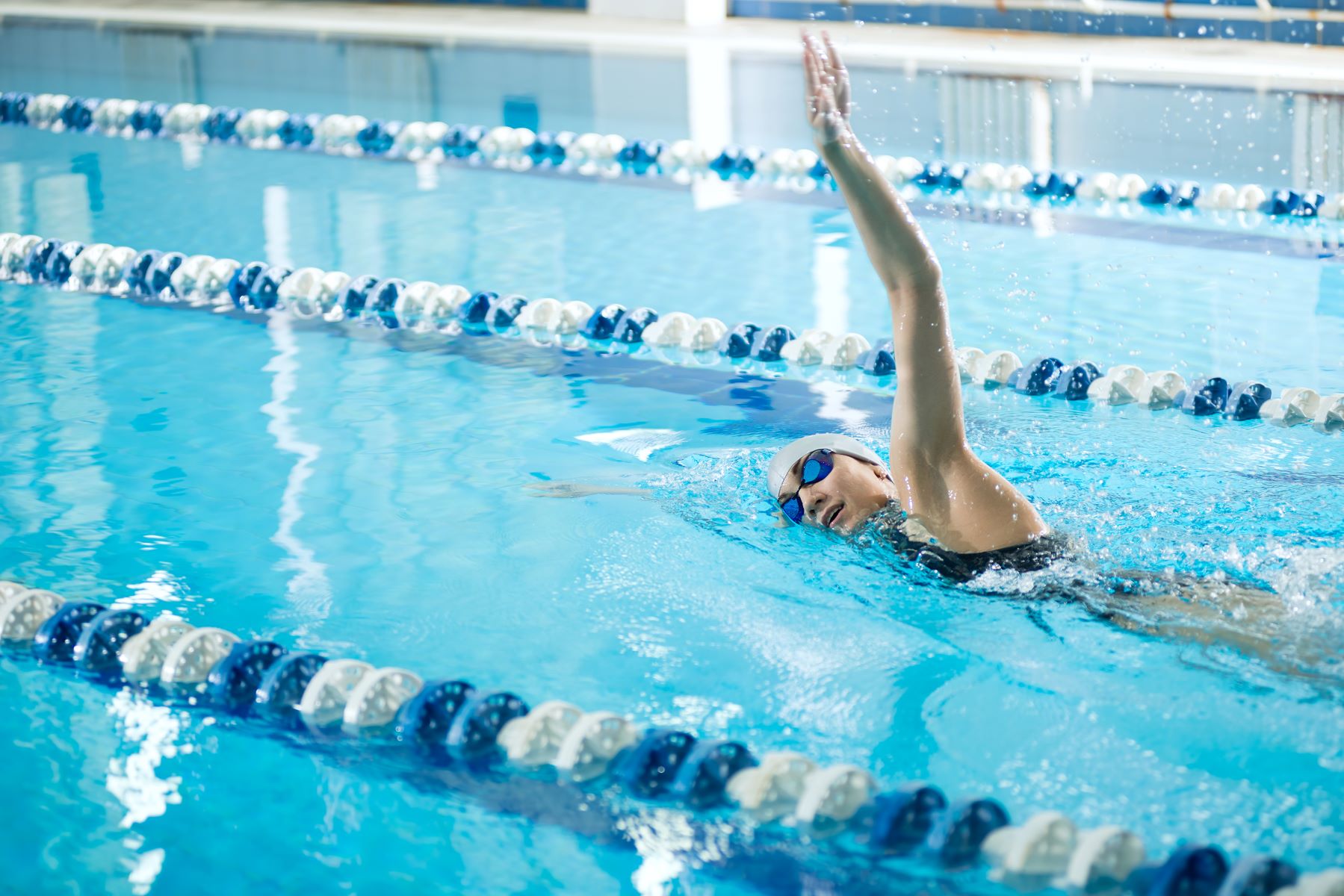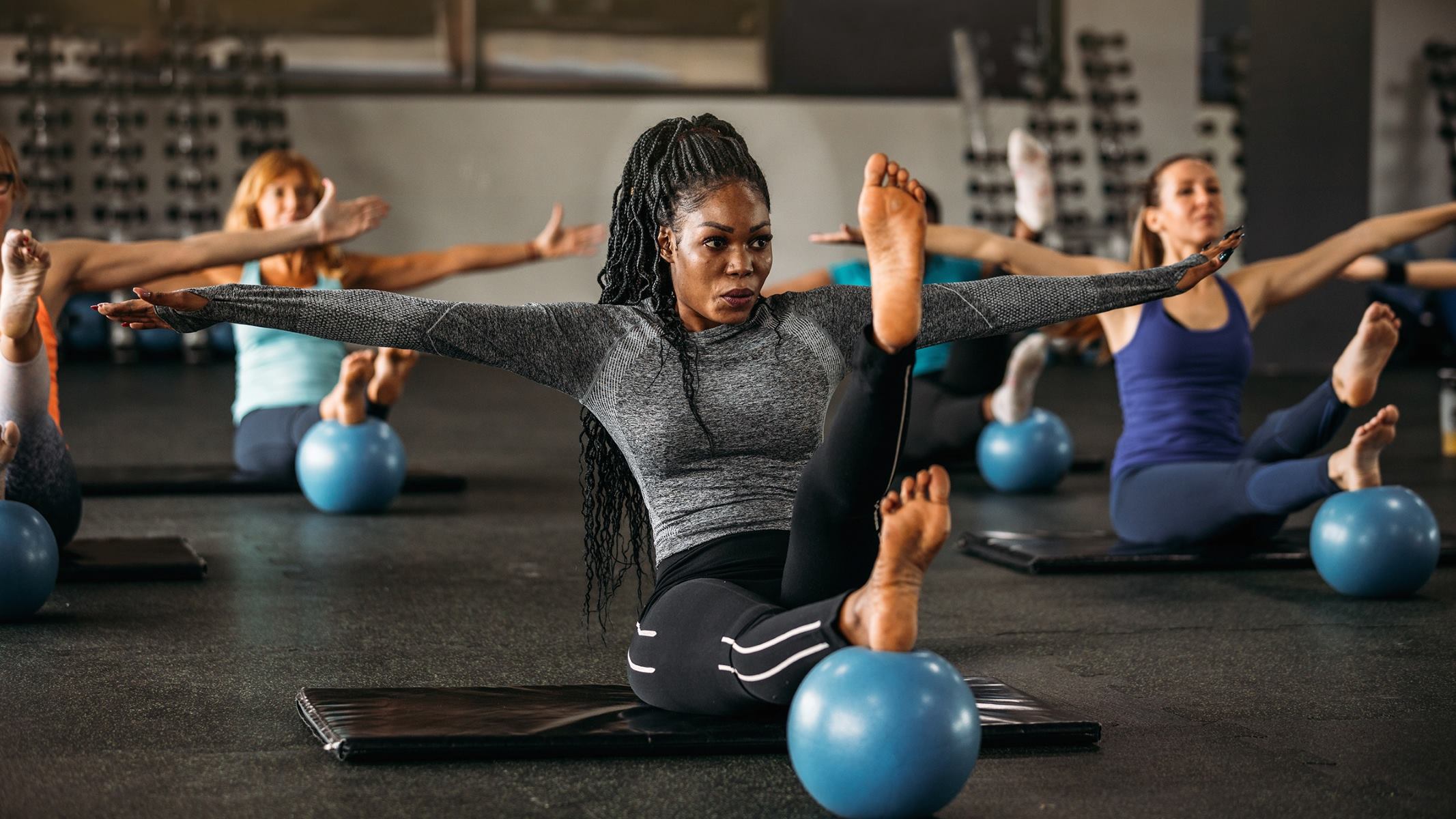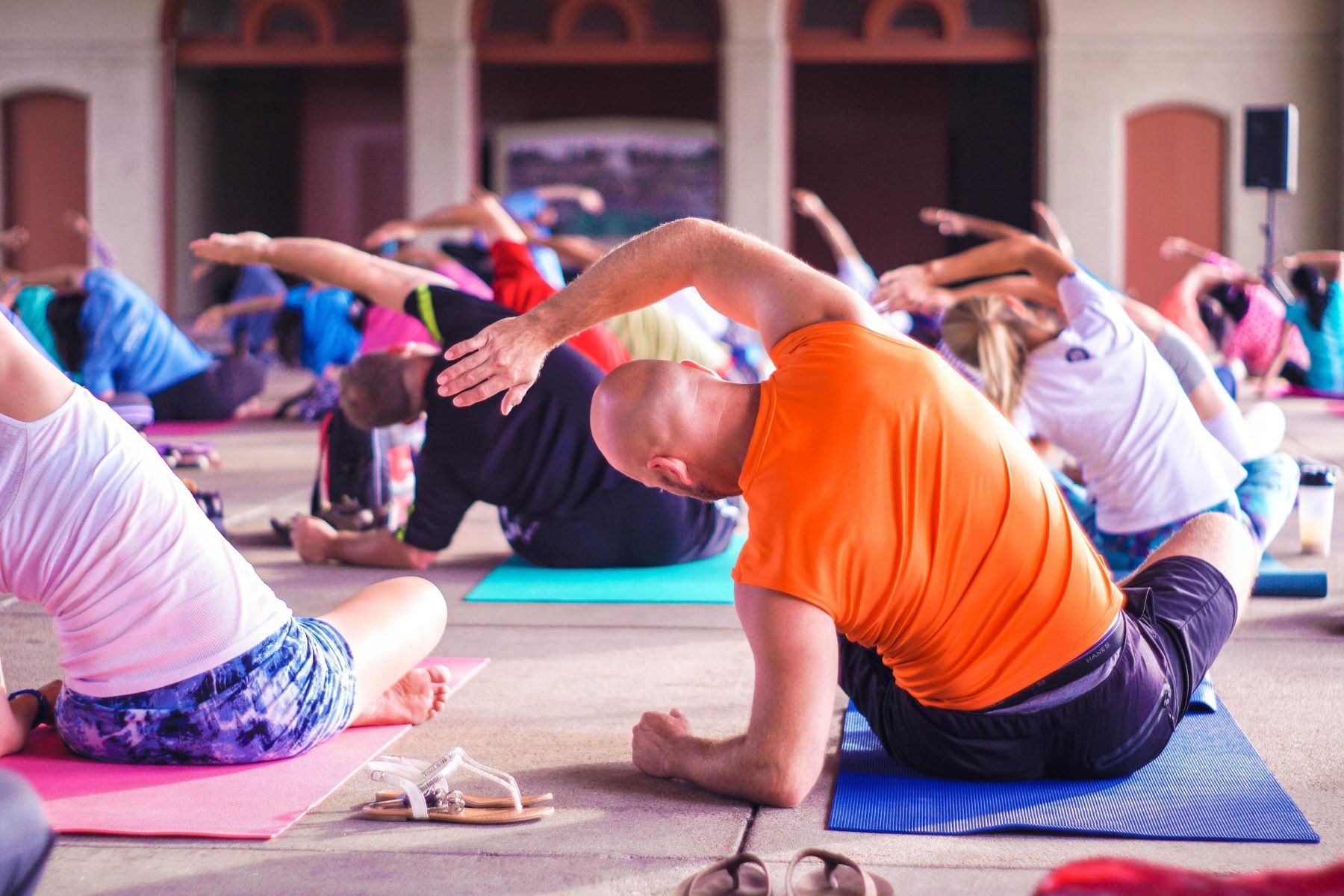Home>Misc>Featured>Which Activities Are Best For Developing Cardiorespiratory Endurance?


Featured
Which Activities Are Best For Developing Cardiorespiratory Endurance?
Modified: January 22, 2024
Discover the featured activities that are ideal for enhancing your cardiorespiratory endurance and achieving optimal fitness levels. Explore effective and enjoyable exercises to boost your cardiovascular health.
Introduction
Cardiorespiratory endurance refers to the ability of the cardiovascular and respiratory systems to sustain prolonged physical activity. It plays a crucial role in maintaining overall health and fitness. By improving cardiorespiratory endurance, individuals can enhance their stamina, endurance, and energy levels, allowing them to perform daily activities with ease and excel in various sports and physical activities.
Developing cardiorespiratory endurance involves engaging in specific exercises and activities that challenge and strengthen the heart, lungs, and circulatory system. These activities help improve the delivery of oxygen to the muscles, increase stamina, and enhance cardiovascular efficiency.
Cardiorespiratory endurance is influenced by various factors such as genetics, age, gender, and lifestyle choices. Some people naturally have a higher level of cardiorespiratory endurance, while others may need to work harder to improve it. Regardless of the starting point, anyone can enhance their cardiorespiratory endurance through regular exercise and a progressive training program.
In this article, we will explore the importance of developing cardiorespiratory endurance and discuss several activities that are highly effective in improving this aspect of fitness. Whether you’re a beginner looking to start your fitness journey or an athlete aiming to enhance your performance, these activities will help you achieve your goals.
Definition of Cardiorespiratory Endurance
Cardiorespiratory endurance, also known as aerobic endurance, refers to the body’s ability to perform prolonged physical activity involving large muscle groups at a moderate to high intensity. It is a measure of how efficiently the cardiovascular and respiratory systems work together to supply oxygen to the working muscles during exercise.
Cardiorespiratory endurance is commonly assessed through tests like the VO2 max test, which measures the maximum amount of oxygen a person can utilize during intense exercise. A higher VO2 max indicates better cardiorespiratory endurance and indicates that the individual can sustain physical activity for a longer duration before fatigue sets in.
When individuals engage in activities that challenge the cardiovascular and respiratory systems, such as running, cycling, or swimming, it increases the demand for oxygen. The heart pumps blood more efficiently, delivering oxygen and nutrients to the working muscles while removing waste products like carbon dioxide.
Improving cardiorespiratory endurance results in various physiological adaptations. The heart becomes stronger, allowing it to pump more blood with each beat. The lungs become more efficient in exchanging oxygen and carbon dioxide. The body produces and utilizes energy more effectively, leading to enhanced stamina and endurance.
Cardiorespiratory endurance is an essential component of overall fitness. It not only improves one’s ability to perform physical tasks but also plays a crucial role in reducing the risk of cardiovascular diseases, such as heart disease and high blood pressure. Regular exercise aimed at improving cardiorespiratory endurance also helps in weight management and enhances mental well-being.
Overall, cardiorespiratory endurance forms the foundation of physical fitness and is vital for leading a healthy and active lifestyle. By understanding its definition and importance, individuals can be motivated to engage in activities that improve their cardiovascular and respiratory systems, leading to improved overall fitness and well-being.
Importance of Developing Cardiorespiratory Endurance
Developing cardiorespiratory endurance is crucial for improving overall health and fitness. It offers numerous benefits that positively impact various aspects of daily life. Here are some key reasons why developing cardiorespiratory endurance is important:
1. Improved Stamina and Endurance: Engaging in activities that enhance cardiorespiratory endurance helps increase stamina and endurance. This means you can perform physical activities for longer periods without feeling fatigued, whether it’s climbing stairs, going for a run, or participating in sports. Improved stamina and endurance also make daily tasks feel less exhausting, allowing you to maintain a higher level of productivity throughout the day.
2. Enhanced Cardiovascular Health: Regular aerobic exercise that promotes cardiorespiratory endurance strengthens the heart muscle, enabling it to pump blood more efficiently. This improves blood circulation and lowers the risk of developing cardiovascular diseases such as heart disease, high blood pressure, and stroke. A strong and healthy cardiovascular system is essential for overall well-being.
3. Weight Management: Developing cardiorespiratory endurance aids in weight management and contributes to maintaining a healthy body weight. During cardiovascular exercise, the body burns calories, helping to create a calorie deficit and promote weight loss. It also helps to tone and shape the body, as it engages multiple muscle groups and supports muscle development.
4. Increased Energy Levels: Regular exercise that improves cardiorespiratory endurance helps boost energy levels. When the cardiovascular and respiratory systems are strong and efficient, the body gains the ability to deliver oxygen and nutrients efficiently to the muscles and organs. As a result, individuals experience increased energy and vitality, allowing them to tackle daily activities with ease and enthusiasm.
5. Stress Reduction and Mental Well-Being: Engaging in cardiorespiratory endurance activities, such as running, swimming, or cycling, helps release endorphins, which are known as the body’s natural feel-good chemicals. These endorphins promote a positive mood, reduce stress, and alleviate symptoms of anxiety and depression. Regular exercise not only benefits physical health but also supports mental and emotional well-being.
6. Improved Quality of Sleep: Regular physical activity, including cardiorespiratory endurance training, can improve the quality and duration of sleep. Exercise helps regulate the sleep-wake cycle, allowing individuals to fall asleep faster and experience deeper, more restorative sleep. Adequate sleep is essential for overall health and contributes to improved cognitive function and daytime productivity.
By developing cardiorespiratory endurance through regular exercise, individuals can experience these wide-ranging benefits. The ability to engage in physical activities with less fatigue, enhance cardiovascular health, manage weight, boost energy levels, reduce stress, improve sleep quality, and enhance overall well-being makes developing cardiorespiratory endurance an essential component of a healthy and active lifestyle.
Factors Affecting Cardiorespiratory Endurance
Cardiorespiratory endurance is influenced by various factors that can either positively or negatively affect an individual’s ability to improve and maintain high levels of aerobic fitness. Understanding these factors can help individuals tailor their training programs and make lifestyle choices that support the development of cardiorespiratory endurance. Here are some key factors that affect cardiorespiratory endurance:
1. Genetics: Genetic factors play a significant role in determining an individual’s baseline cardiorespiratory endurance. Some people are naturally predisposed to have higher levels of aerobic fitness due to genetic factors such as the efficiency of their cardiovascular and respiratory systems. However, genetic potential does not preclude the ability to improve cardiorespiratory endurance through regular exercise.
2. Age: Age is an important factor affecting cardiorespiratory endurance. As individuals age, their maximum heart rate, lung capacity, and overall aerobic capacity tend to decrease. However, with regular exercise, individuals can slow down the decline in cardiorespiratory fitness associated with aging and maintain a higher level of aerobic fitness.
3. Gender: In general, men tend to have higher cardiorespiratory endurance than women. This difference is partially attributed to physiological factors such as higher hemoglobin levels, greater lung capacity, and higher muscle mass in men. However, it’s important to note that with proper training, women can develop excellent cardiorespiratory endurance and compete at high levels in endurance sports.
4. Lifestyle Choices: Lifestyle choices such as physical activity level, diet, smoking, and alcohol consumption can significantly impact cardiorespiratory endurance. Regular aerobic exercise is essential for improving and maintaining cardiorespiratory fitness. A well-balanced diet provides the necessary nutrients for energy production, and avoiding tobacco and excessive alcohol consumption supports overall cardiovascular health.
5. Training Program: The type, intensity, duration, and frequency of exercise in a training program can greatly influence cardiorespiratory endurance. A well-designed program should include aerobic activities that challenge the cardiovascular and respiratory systems, progressively increasing in intensity and duration over time. Consistency is key, as regular exercise stimulates physiological adaptations that lead to improved cardiorespiratory fitness.
6. Environment: Environmental conditions such as altitude, temperature, and humidity can affect cardiorespiratory endurance. Training at high altitude, for example, can enhance aerobic capacity due to the lower oxygen availability. Extreme temperatures and high humidity can make exercise more challenging, as the body has to work harder to regulate temperature and maintain optimal performance.
While these factors may influence cardiorespiratory endurance, it’s essential to remember that everyone can improve their aerobic fitness through consistent training and making healthy lifestyle choices. By understanding how these factors impact cardiorespiratory endurance, individuals can make informed decisions to optimize their training programs and maximize their aerobic fitness potential.
Guidelines for Developing Cardiorespiratory Endurance
Developing cardiorespiratory endurance requires a structured approach that combines regular aerobic exercise, progressive overload, and proper recovery. By following these guidelines, individuals can effectively improve their aerobic fitness and enhance their overall health and well-being. Here are some key guidelines to consider:
1. Choose Aerobic Activities: Engage in aerobic activities that elevate your heart rate and challenge your cardiovascular and respiratory systems. These can include activities such as running, cycling, swimming, brisk walking, dancing, or using cardio machines like the elliptical or stair climber.
2. Start Slowly and Progress Gradually: If you’re new to exercise or have been inactive for a while, start with low-intensity activities and gradually increase the duration and intensity of your workouts. This gradual progression allows your body to adapt and prevents excessive strain or injury.
3. Aim for Moderate Intensity: Work at a moderate intensity level where you can still hold a conversation but feel slightly breathless. This intensity ensures that you’re challenging your cardiovascular system without overexerting yourself.
4. Vary Your Workouts: Incorporate different types of aerobic activities into your routine to prevent boredom and work different muscle groups. This variety also helps improve overall fitness by challenging the body in different ways.
5. Include Interval Training: Interval training involves alternating periods of high-intensity exercise with periods of active recovery. This type of training is an effective way to improve cardiorespiratory endurance and burn calories. For example, you can alternate between one minute of sprinting and two minutes of jogging.
6. Consider Circuit Training: Circuit training combines cardiovascular exercises with strength training exercises in a fast-paced, sequential manner. This type of training improves both muscular strength and endurance while challenging the cardiovascular system.
7. Incorporate High-Intensity Interval Training (HIIT): HIIT involves short bursts of intense exercise followed by short recovery periods. This type of training is time-efficient and highly effective in improving cardiorespiratory endurance. It can be done with exercises like sprinting, cycling, or bodyweight exercises.
8. Allow Sufficient Recovery: Give your body time to recover between workouts. Adequate rest and recovery are essential for adaptation and preventing overuse injuries. Include active recovery days with low-intensity activities such as yoga, walking, or stretching.
9. Listen to Your Body: Pay attention to how your body feels during exercise. If you experience pain, dizziness, or excessive fatigue, it’s important to modify your workouts or seek guidance from a healthcare professional.
10. Stay Consistent: Consistency is key when developing cardiorespiratory endurance. Aim for at least 150 minutes of moderate-intensity aerobic exercise or 75 minutes of vigorous-intensity exercise each week. Make exercise a regular part of your routine to maintain and improve your aerobic fitness.
By following these guidelines, individuals can progressively develop their cardiorespiratory endurance, leading to improved stamina, energy levels, and overall health. Remember to consult with a healthcare professional before starting any exercise program, especially if you have any underlying health conditions or concerns.
Aerobic Activities
Aerobic activities are an excellent way to improve cardiorespiratory endurance as they involve continuous, rhythmic movements that elevate the heart rate and increase oxygen consumption. These activities engage large muscle groups and challenge the cardiovascular and respiratory systems. Here are some popular aerobic activities to consider:
1. Running: Running is a widely accessible and effective aerobic activity that can be done outdoors or on a treadmill. It helps improve cardiovascular fitness, burns calories, and strengthens the lower body muscles. Start with a comfortable pace and gradually increase your duration and intensity.
2. Cycling: Cycling is a low-impact activity that can be done outdoors or on a stationary bike. It is excellent for building cardiorespiratory endurance, strengthening the leg muscles, and improving joint mobility. Adjust the resistance or terrain to vary the intensity of your workout.
3. Swimming: Swimming is a full-body aerobic exercise that provides a low-impact workout. It works multiple muscle groups simultaneously while improving overall cardiovascular fitness. The water’s buoyancy reduces stress on the joints, making it a suitable option for individuals with joint issues.
4. Brisk Walking: Brisk walking is a simple and accessible aerobic activity that can be incorporated into your daily routine. Walking at a brisk pace increases heart rate, improves cardiovascular health, and burns calories. Aim for a walking pace that allows you to speak comfortably but still feel slightly breathless.
5. Dancing: Dancing is a fun and engaging aerobic activity that can be enjoyed in various forms, such as Zumba, ballet, or hip-hop. Dancing not only improves cardiorespiratory endurance but also enhances coordination, balance, and flexibility. Join a dance class or follow online tutorials to get started.
6. Jumping Rope: Jumping rope is a fantastic aerobic workout that can be done anywhere. It is a high-intensity exercise that improves cardiovascular fitness, coordination, and agility. Start with shorter intervals and gradually increase your speed and duration as your endurance improves.
7. Group Fitness Classes: Group fitness classes such as aerobics, step aerobics, kickboxing, or cardio dance classes offer a structured and motivating environment to improve cardiorespiratory endurance. These classes often incorporate high-energy movements and upbeat music to keep you engaged.
8. Elliptical Trainer: The elliptical trainer provides a low-impact workout that mimics the motion of walking, running, or stair climbing. It targets multiple muscle groups and allows you to adjust the resistance and incline to increase the intensity of your workout.
9. Rowing: Rowing is a total-body workout that engages the upper and lower body muscles while challenging the cardiovascular system. Rowing machines or participating in rowing classes can help improve cardiorespiratory endurance and build strength.
10. Circuit Training: Circuit training involves performing a series of aerobic exercises with minimal rest in between. This combines both cardiovascular and strength training benefits, making it an efficient way to improve aerobic fitness while building muscular endurance.
Remember to choose activities that you enjoy and that suit your fitness level and preferences. Aim for at least 150 minutes of moderate-intensity aerobic exercise or 75 minutes of vigorous-intensity exercise each week, spread across multiple days. Gradually increase the duration, intensity, and variety of your aerobic activities to continue challenging your cardiorespiratory system and maximizing your endurance gains.
Interval Training
Interval training is a highly effective method for improving cardiorespiratory endurance and pushing your fitness boundaries. It involves alternating between periods of high-intensity exercise and active recovery. This alternating pattern challenges the cardiovascular system, improves aerobic capacity, and burns calories. Here’s how to incorporate interval training into your workout routine:
1. Choose Your Exercise: Interval training can be done with various aerobic activities such as running, cycling, swimming, or using cardio machines like the elliptical or rowing machine. Select an exercise that you enjoy and feel comfortable performing.
2. Warm Up: Start with a 5-10 minute warm-up at a moderate pace to prepare your body for the intense intervals. This could include light jogging, cycling, or dynamic stretching.
3. Select Your Intervals: Determine the duration and intensity of your interval and recovery periods. For example, you might do 30 seconds of all-out effort followed by 60 seconds of low-intensity recovery. As you progress, you can increase the duration of the high-intensity interval and decrease the recovery period.
4. Perform the Intervals: Begin with the high-intensity phase, giving it your maximum effort. This could involve sprinting, cycling at a challenging pace, or increasing the resistance on the elliptical. Maintain the intensity for the designated duration.
5. Active Recovery: After completing each high-intensity interval, switch to the active recovery phase. Reduce the intensity to a comfortable pace that allows you to catch your breath and recover. This could involve jogging, walking, or cycling at a slower pace.
6. Repeat the Cycle: Continue alternating between high-intensity intervals and active recovery periods for the desired number of repetitions. Aim for 4-6 intervals in a session, gradually increasing as your fitness improves.
7. Cool Down: After completing all the intervals, finish with a 5-10 minute cool-down at a lower intensity. This helps bring your heart rate and breathing back to normal gradually.
Interval training provides several benefits for cardiorespiratory endurance. The high-intensity intervals push your cardiovascular system to its limits, improving your aerobic capacity and increasing the efficiency of oxygen delivery to your muscles. The active recovery periods allow your body to recover and prepare for the next intense interval, enabling you to sustain a high level of effort throughout the workout.
This type of training offers versatility in terms of duration and intensity, allowing you to tailor it to your fitness level and goals. It can be modified for beginners with shorter intervals and longer recovery periods, gradually progressing to more intense intervals as endurance improves.
Additionally, interval training elevates your metabolism, leading to increased calorie burn even after the workout is complete. This makes it an effective strategy for weight loss and overall body composition improvements.
Remember to listen to your body during interval training. Start with intervals that challenge you without pushing you to the point of exhaustion or compromising proper form. As your endurance improves, you can increase the duration and intensity of your intervals to continue challenging yourself and improving your cardiorespiratory endurance.
Circuit Training
Circuit training is a dynamic and efficient form of exercise that combines cardiovascular conditioning with strength training. It involves performing a series of exercises in a circuit format, with minimal rest in between. Circuit training enhances cardiorespiratory endurance, improves muscular strength and endurance, and increases overall fitness levels. Here’s how to incorporate circuit training into your fitness routine:
1. Select Your Exercises: Choose a variety of exercises that work different muscle groups and elevate your heart rate. Include exercises like jumping jacks, push-ups, squats, lunges, burpees, mountain climbers, and kettlebell swings. Aim for a combination of upper body, lower body, and core exercises.
2. Set Up Your Circuit: Arrange the exercises in a circuit format, creating a sequence of stations. Determine the number of repetitions or duration for each exercise based on your fitness level and goals. You can start with 8-10 exercises and perform each exercise for 30-60 seconds.
3. Warm Up: Begin with a 5-10 minute warm-up to prepare your body for the workout. Include dynamic stretches and movements to increase your body temperature and loosen up your muscles.
4. Perform the Circuit: Move through each exercise in the circuit, performing the designated number of repetitions or duration for each exercise. Take minimal rest between exercises, transitioning smoothly from one to the next. Complete one full round of the circuit.
5. Rest and Repeat: After completing one round, take a short rest of 1-2 minutes before starting the next round. Aim to complete 2-3 rounds of the circuit. As your fitness improves, you can increase the number of rounds or increase the intensity of the exercises.
6. Cool Down: Once you have finished all the rounds of the circuit, cool down with 5-10 minutes of stretching exercises to help your muscles recover and prevent post-workout tightness.
Circuit training offers numerous benefits for cardiorespiratory endurance and overall fitness. By incorporating both cardiovascular exercises and strength training movements into a single workout, circuit training provides a comprehensive and time-efficient approach to improve aerobic fitness and build muscular strength.
The continuous movement and limited rest periods in circuit training help keep your heart rate elevated throughout the workout, challenging your cardiovascular system and improving endurance. The multiple exercises also engage various muscle groups, enhancing muscular endurance and promoting overall strength development.
In addition to the physical benefits, circuit training can be a fun and engaging workout. The variety of exercises keeps your workout fresh and exciting, preventing boredom and monotony. It can also be modified to suit different fitness levels, making it accessible to individuals of all abilities.
Whether you’re a beginner looking to improve your overall fitness or an experienced athlete seeking to enhance your cardiorespiratory endurance, circuit training is an effective and versatile training method to consider. By incorporating regular circuit training sessions into your fitness routine, you can experience improvements in cardiovascular fitness, muscular strength, and overall endurance.
High-Intensity Interval Training (HIIT)
High-Intensity Interval Training (HIIT) is a popular and time-efficient form of exercise that combines short bursts of intense exercise with periods of active recovery. This training method effectively improves cardiorespiratory endurance, burns calories, and boosts metabolism. HIIT sessions typically last between 20 to 30 minutes, making it a convenient option for individuals with busy schedules. Here’s what you need to know about incorporating HIIT into your fitness routine:
1. Choose Your Exercises: HIIT can be done with a variety of aerobic exercises such as running, cycling, jumping rope, burpees, or high knees. Select exercises that engage multiple muscle groups and elevate your heart rate.
2. Set Your Intervals: Determine the duration of your high-intensity and recovery intervals. A common ratio is 1:1, meaning you work at maximum effort for 20 seconds and then recover for 20 seconds. As you progress, you can adjust the ratio to work at a higher intensity for shorter intervals.
3. Warm Up: Begin with a 5-10 minute warm-up to prepare your body for the intense workout. Engage in dynamic movements like jogging, jumping jacks, or lunges.
4. Perform the Intervals: Start with the high-intensity phase, giving your maximum effort during the designated interval. Perform explosive movements or increase resistance, pushing yourself to your limits.
5. Active Recovery: After completing each high-intensity interval, switch to the active recovery phase. Reduce the intensity to a comfortable pace that allows you to catch your breath and recover. This could involve slower jogging, walking, or gentle cycling.
6. Repeat the Cycle: Continue alternating between high-intensity intervals and active recovery periods for the desired number of repetitions. Aim for 8-10 cycles, gradually increasing as your fitness improves.
7. Cool Down: After completing the intervals, finish with a 5-10 minute cool-down. Incorporate static stretches to help your muscles recover and prevent tightness.
HIIT offers numerous benefits for cardiorespiratory endurance. By pushing your body to work at a high intensity during the intervals, your heart rate increases, and your cardiovascular system is challenged. This leads to improved aerobic capacity, increased oxygen utilization, and enhanced overall fitness. Additionally, the short recovery periods help improve the body’s ability to recover quickly after intense exercise.
The intensity and efficiency of HIIT also make it an effective calorie-burning workout. The intense bursts of exercise followed by brief recovery periods create an “afterburn effect,” where your body continues to burn calories for hours even after the workout is complete.
It’s important to note that HIIT is a challenging form of exercise and may not be suitable for everyone. If you have any underlying health conditions or are new to exercise, it’s recommended to consult with a healthcare professional before incorporating HIIT into your routine.
Overall, HIIT offers a time-efficient and effective way to improve cardiorespiratory endurance. By incorporating regular HIIT sessions into your fitness routine, you can experience significant improvements in cardiovascular fitness, calorie burn, and overall endurance. Push yourself, but listen to your body and adjust the intensity and duration of intervals to suit your fitness level and goals.
Running and Jogging
Running and jogging are popular forms of aerobic exercise that can greatly improve cardiorespiratory endurance and overall fitness levels. These activities require no special equipment, can be done almost anywhere, and offer numerous health benefits. Whether you’re a seasoned runner or new to jogging, here’s why you should consider incorporating running or jogging into your fitness routine:
1. Improved Cardiovascular Fitness: Running and jogging are excellent cardiovascular exercises that help strengthen your heart and lungs. Regular running or jogging sessions increase your heart rate, improve blood circulation, and enhance the efficiency of your cardiovascular system.
2. Weight Management: Running and jogging are effective calorie-burning exercises. They help create a calorie deficit, leading to weight loss and weight management. Incorporating running or jogging into your routine, along with a balanced diet, can contribute to weight loss goals.
3. Enhanced Muscular Endurance: Running and jogging work various muscle groups in your lower body, including the quadriceps, hamstrings, calves, and glutes. Regular running or jogging helps strengthen and tone these muscles, enhancing muscular endurance and preventing muscle imbalances.
4. Improved Bone Health: Running and jogging are weight-bearing exercises that help improve bone density, reducing the risk of osteoporosis. The impact of each foot landing stimulates bone growth, making your bones stronger and more resistant to fractures.
5. Mental Well-being: Running and jogging have positive effects on mental health. The release of endorphins during exercise promotes a sense of well-being, reduces stress, and helps alleviate symptoms of anxiety and depression. It can also improve sleep quality and promote better cognitive function.
6. Versatile and Adaptable: Running and jogging can be easily modified to suit your fitness level and goals. You can adjust the intensity by altering your pace, distance, or terrain. Whether you prefer a leisurely jog or an intense sprint, you can tailor your running or jogging sessions to meet your needs.
7. Promotes Goal Setting and Achievement: Running and jogging provide a tangible sense of accomplishment as you set distance or time goals and work towards achieving them. Regular progress in your running or jogging routine can boost self-confidence and motivate you to push your limits further.
8. Social Connection: Participating in group runs, joining local running clubs, or running with a buddy can create a sense of community and social connection. It provides an opportunity to meet like-minded individuals and share your fitness journey.
9. Convenient and Accessible: Running and jogging require minimal equipment and can be done practically anywhere, whether it’s outdoors, on a treadmill, or even in your home. This accessibility makes it an ideal choice for individuals with busy schedules or limited access to gyms or fitness facilities.
Remember to start gradually if you’re new to running or jogging. Begin with a combination of walking and jogging, gradually increasing the duration and intensity of your runs as your fitness improves. Ensure proper footwear, hydrate adequately, and listen to your body. If you experience any pain or discomfort, it’s important to rest and consult with a healthcare professional.
Incorporating running or jogging into your fitness routine has numerous physical and mental health benefits. It’s a versatile and accessible form of exercise that can significantly improve your cardiorespiratory endurance, help manage weight, strengthen muscles, and promote overall well-being. Lace up your shoes, hit the road, and enjoy the many benefits that running or jogging can offer.
Cycling
Cycling is a highly effective aerobic activity that improves cardiorespiratory endurance, strengthens muscles, and provides a range of health benefits. Whether you prefer outdoor cycling or indoor stationary biking, this low-impact exercise offers a great way to improve your fitness and overall well-being. Here are some reasons why you should consider incorporating cycling into your fitness routine:
1. Aerobic Fitness: Cycling is an excellent cardiovascular exercise that increases your heart rate, improves lung capacity, and boosts overall aerobic fitness. Regular cycling sessions challenge your cardiovascular system, enhancing its efficiency and endurance.
2. Low Impact: Cycling is a low-impact exercise that puts minimal stress on your joints, making it suitable for individuals of all ages and fitness levels. It provides a gentler alternative to high-impact exercises like running, while still offering an effective cardio workout.
3. Muscular Strength and Endurance: Cycling engages the major muscle groups in your lower body, including the quadriceps, hamstrings, glutes, and calves. As you pedal, these muscles work together, improving strength, endurance, and toning.
4. Weight Management: Cycling is an effective calorie-burning activity that can contribute to weight management and weight loss. It helps create a calorie deficit, resulting in the reduction of body fat when combined with a healthy diet.
5. Joint Health: Cycling is a non-weight-bearing exercise, which reduces the impact on your joints. It helps improve joint mobility and flexibility, making it a suitable exercise for individuals with joint conditions or those recovering from injuries.
6. Convenience and Accessibility: Cycling can be done outdoors or indoors, depending on your preference and location. Outdoor cycling allows you to enjoy the fresh air, explore new routes, and experience the therapeutic benefits of nature. Stationary biking provides a convenient option for indoor workouts, allowing you to pedal regardless of weather conditions.
7. Variety of Intensities: Cycling offers a range of intensities, from leisurely rides to high-intensity interval training. You can adjust the resistance, speed, or terrain to make your cycling sessions more challenging or relaxing, depending on your goals and fitness level.
8. Improved Mental Health: Cycling, like any form of exercise, has positive effects on mental well-being. It reduces stress, boosts mood, and promotes relaxation. Cycling outdoors also provides an opportunity to connect with nature and enjoy the sense of freedom and adventure.
9. Social Engagement: Cycling can be a social activity that allows you to connect with fellow cyclists through group rides, cycling clubs, or events. It offers a sense of camaraderie, motivation, and support while enjoying the company of like-minded individuals.
10. Sustainable Transportation: Incorporating cycling into your daily routine as a mode of transportation not only benefits your health but also reduces carbon emissions and contributes to a more sustainable environment.
Whether you choose to embark on long-distance road cycling, mountain biking, or indoor cycling classes, cycling provides a fun and effective way to improve your cardiorespiratory fitness, strengthen muscles, and enjoy the outdoors. Remember to wear appropriate safety equipment, hydrate adequately, and adjust your bike to ensure proper ergonomics. Start with shorter rides, gradually increasing your distance and intensity as your fitness progresses. Enjoy the journey and reap the many physical and mental health benefits that cycling can provide.
Swimming
Swimming is a highly effective aerobic activity that offers a full-body workout while improving cardiorespiratory endurance, strength, and flexibility. Whether you swim laps in a pool or take part in open water swimming, this low-impact exercise provides numerous health benefits. Here are some reasons why you should consider incorporating swimming into your fitness routine:
1. Total-Body Workout: Swimming engages all major muscle groups in your body, including your arms, legs, core, and back. It provides a comprehensive workout that strengthens and tones muscles while improving overall muscular endurance.
2. Cardiovascular Fitness: Swimming is an excellent cardiovascular exercise that increases your heart rate, improves lung capacity, and enhances aerobic endurance. It challenges your cardiovascular system, improving its efficiency over time.
3. Low-Impact Exercise: Swimming is a low-impact activity that puts minimal stress on your joints, making it suitable for individuals of all ages and fitness levels. The buoyancy of water provides support, reducing the risk of injury and making swimming a great option for those with joint conditions or injuries.
4. Enhanced Flexibility: The range of motion required in swimming promotes flexibility in your joints and muscles. This increased flexibility helps improve overall mobility and may reduce the risk of injuries and muscle imbalances.
5. Improved Respiratory Health: Swimming involves controlled breathing techniques that promote efficient oxygen intake and carbon dioxide release. These breathing patterns help strengthen your respiratory muscles and enhance lung capacity.
6. Weight Management: Swimming is an effective calorie-burning exercise that can contribute to weight management and weight loss. It provides a full-body workout, burning calories and boosting metabolism even after your swim session has ended.
7. Mental Well-being: Like other forms of aerobic exercise, swimming has positive effects on mental health. The repetitive nature of swimming, combined with the calming environment of the water, can help reduce stress, improve mood, and promote relaxation.
8. Safe for All Fitness Levels: Swimming allows you to control the intensity of your workout based on your fitness level and goals. Whether you’re a beginner or an experienced swimmer, you can adapt your swimming routine by adjusting your pace, distance, and stroke technique.
9. Versatility and Variety: Swimming offers a variety of strokes and swimming techniques, allowing you to add variety to your workouts. You can swim different strokes like freestyle, backstroke, breaststroke, or butterfly, focusing on different muscle groups and challenging yourself in different ways.
10. Heat Regulation: Swimming helps regulate body temperature, making it an ideal exercise in hot weather. The cooling effect of the water prevents overheating and allows for longer, more comfortable workouts.
Whether you swim for leisure, fitness, or competitive purposes, swimming provides a refreshing and effective way to improve your cardiovascular fitness, build strength, and enhance overall well-being. It’s important to practice proper swimming techniques, stay hydrated, and seek assistance if needed, especially when swimming in open water. With consistency and dedication, swimming can be a lifelong form of exercise that helps you reach your fitness goals.
Jumping Rope
Jumping rope, also known as skipping rope, is a simple yet highly effective aerobic exercise that offers a range of health benefits. Whether you’re a beginner or an experienced fitness enthusiast, incorporating jumping rope into your workout routine can improve your cardiorespiratory endurance, coordination, and overall fitness level. Here’s why you should consider jumping rope as a part of your fitness regimen:
1. Cardiovascular Fitness: Jumping rope is a phenomenal cardiovascular exercise that gets your heart rate up, increasing oxygen delivery throughout your body and improving overall aerobic capacity. The continuous jumping motion challenges your cardiovascular system, enhancing its efficiency and endurance.
2. Full-Body Workout: Jumping rope engages multiple muscle groups, including your legs, core, arms, and shoulders. The repetitive jumping motion strengthens your lower body muscles while also improving upper body coordination and muscle tone.
3. Portability and Convenience: Jumping rope requires minimal equipment and space, making it a convenient workout option that can be done both indoors and outdoors. It’s a portable exercise tool that you can easily take with you anywhere, enabling you to maintain your fitness routine while traveling or on-the-go.
4. Calorie Burning: Jumping rope is a high-intensity exercise that burns a significant number of calories in a short period. It can be an effective addition to a weight loss or weight management program, as it helps create a calorie deficit and boosts metabolism.
5. Improved Coordination and Agility: Jumping rope requires coordination between your hands and feet, enhancing your overall motor skills and agility. Over time, you’ll develop better timing and rhythm, which can translate to improved athletic performance in various sports and activities.
6. Bone Density and Joint Health: The impact of jumping rope contributes to the development of stronger bones and can help improve bone density. It can also enhance joint strength and stability when performed with proper technique, which may help prevent certain joint-related conditions or injuries.
7. Variety and Progression: Jumping rope allows for a wide range of variations and progressions to keep your workouts challenging and interesting. You can try different jumping styles, such as single jumps, double unders, or crossover jumps, to add variety and increase the intensity of your workout.
8. Low Cost: Jumping rope is an affordable exercise option compared to many other fitness activities. All you need is a sturdy jump rope, which is relatively inexpensive and durable, making it a budget-friendly investment for long-term use.
9. Stress Relief and Mental Well-being: Jumping rope, like other forms of exercise, releases endorphins, which are known as the “feel-good” hormones. Regular jumping rope sessions can help reduce stress, improve mood, and promote mental well-being.
10. Versatility for All Fitness Levels: Jumping rope can be tailored to suit different fitness levels, from beginners to advanced athletes. You can modify the intensity, speed, and duration of your jumps to match your current fitness level and gradually progress as you become more proficient.
Whether you’re looking to improve your cardiovascular fitness, burn calories, or enhance your overall athleticism, jumping rope is a fun and effective exercise option. As with any high-impact activity, it’s important to start gradually and use proper form to minimize the risk of injury. Take time to warm up, select an appropriate jump rope length, and maintain good posture throughout your jumps. With practice and consistency, jumping rope can be an enjoyable and rewarding addition to your fitness routine.
Rowing
Rowing is an excellent full-body exercise that offers a wide range of health and fitness benefits. Whether you row on a machine or in a boat, this low-impact activity provides a challenging workout that targets multiple muscle groups while improving cardiovascular fitness. Here’s why you should consider incorporating rowing into your fitness routine:
1. Cardiovascular Fitness: Rowing is a highly effective cardiovascular exercise that engages large muscle groups in your legs, core, and upper body. It elevates your heart rate, improves lung capacity, and enhances the efficiency of your cardiovascular system.
2. Total-Body Workout: Rowing is a compound exercise that works several major muscle groups simultaneously. The pulling motion engages muscles in your legs, glutes, back, arms, and shoulders, providing a comprehensive full-body workout.
3. Low Impact: Rowing is a low-impact exercise that puts minimal stress on your joints, making it suitable for individuals of all fitness levels and those with joint issues or injuries. It provides a challenging and effective workout without the risk of high-impact exercises like running.
4. Strength and Muscular Endurance: Rowing helps build strength and muscular endurance in your legs, back, and arms. The resistance from the water or rowing machine increases muscular strength and endurance when you pull against it during each stroke.
5. Improved Posture and Core Stability: Rowing requires a strong core to maintain an upright posture throughout the rowing stroke. Regular rowing exercises strengthen your core muscles, which can improve your overall posture, stability, and reduce the risk of back pain.
6. Calorie Burning: Rowing is a calorie-burning exercise that can help with weight management and fat loss. It is known to burn a significant number of calories per hour due to its high-intensity nature and engagement of multiple muscle groups.
7. Joint Mobility and Flexibility: The rowing motion involves a full range of motion for your joints, promoting increased joint mobility and flexibility. This can enhance overall joint health, reduce the risk of injuries, and improve functional movement patterns.
8. Mental Well-being: Rowing, like any form of exercise, can have positive effects on mental health. It can reduce stress, improve mood, and boost overall mental well-being, helping to alleviate symptoms of anxiety and depression.
9. Versatility and Adaptability: Rowing can be easily modified to suit different fitness levels and goals. You can adjust the resistance on a rowing machine or vary the intensity and duration of your rowing workouts, allowing you to progress at your own pace.
10. Teamwork and Community: Rowing can be enjoyed individually or as part of a team. Joining a rowing club or participating in rowing competitions fosters a sense of camaraderie and teamwork, providing opportunities for social interaction and support.
Whether you row on a rowing machine or in open water, incorporating rowing into your fitness routine offers a multitude of benefits for your cardiovascular fitness, muscular strength, and overall well-being. Start with proper technique, gradually increase the intensity and duration of your rowing workouts, and always listen to your body to prevent overexertion or injury. Rowing provides a challenging and rewarding way to achieve your fitness goals while enjoying the serenity of the water or the invigorating workout on a rowing machine.
Dancing
Dancing is a joyful and dynamic form of exercise that not only improves cardiorespiratory endurance but also offers an array of physical and mental health benefits. Whether you join a dance class, hit the dance floor at a social event, or dance in the comfort of your own home, incorporating dancing into your fitness routine can be both fun and rewarding. Here’s why you should consider dancing as a part of your overall fitness regimen:
1. Cardiovascular Fitness: Dancing is a great aerobic activity that gets your heart rate up, improving your cardiovascular fitness. Whether it’s fast-paced dance styles like salsa or energetic dance workouts like Zumba, dancing challenges your cardiovascular system and increases endurance.
2. Muscle Tone and Strength: Dancing engages various muscle groups throughout your body, helping to tone and strengthen them. Different dance styles work different muscles, including the legs, core, arms, and back, contributing to overall muscle development and improved strength.
3. Coordination and Balance: Dancing requires coordination between music, rhythm, and movements. Regular dancing practice enhances coordination, agility, and balance, improving your overall physical control and body awareness.
4. Flexibility and Range of Motion: Dancing incorporates a variety of movements that stretch and lengthen your muscles, promoting flexibility and increasing your range of motion. Regular dancing can lead to improved joint mobility and better overall flexibility.
5. Mental Well-being: Dancing has significant positive effects on mental health. It releases endorphins, the “feel-good” hormones, leading to reduced stress, anxiety, and depression. Dancing also provides an uplifting and creative outlet that promotes self-expression, boosts mood, and enhances overall well-being.
6. Improved Memory and Cognitive Function: Dancing involves learning and remembering dance routines, steps, and patterns. This mental stimulation can improve memory, cognitive function, and help maintain brain health, especially as you age.
7. Stress Relief and Emotional Release: Dancing provides a means of expression and emotional release. It allows you to let go, be yourself, and channel your emotions through movement, promoting stress relief and a sense of freedom.
8. Social Interaction and Sense of Community: Dancing often involves group classes or social dance events, offering opportunities for social interaction, meeting new people, and building connections with like-minded individuals who share a passion for dance. This sense of community can be uplifting and provide ongoing support and motivation.
9. Weight Management: Dancing is a calorie-burning activity that can contribute to weight management. Depending on the intensity and duration of the dance session, it can help burn a significant number of calories, promoting weight loss and supporting a healthy body weight.
10. Flexibility in Style and Format: Dancing offers an extensive range of styles and formats to suit various preferences and fitness levels. From traditional ballroom dances to contemporary styles like hip-hop or jazz, you can choose a dance style that resonates with you and fits your fitness goals and interests.
Whether you dance alone, with a partner, or in a group setting, incorporating dancing into your fitness routine can provide a holistic approach to overall well-being. It offers a blend of physical activity, artistic expression, and social connection that uplifts the body, mind, and spirit. So put on your dancing shoes, embrace the rhythm, and let the music move you toward improved cardiorespiratory endurance and a healthier, happier version of yourself.
Conclusion
Developing cardiorespiratory endurance is essential for improving overall health and fitness. Engaging in activities that challenge the cardiovascular and respiratory systems can enhance stamina, endurance, and energy levels, allowing individuals to perform daily activities with ease and excel in various sports and physical endeavors.
There are various factors that can affect cardiorespiratory endurance, including genetics, age, gender, lifestyle choices, and training programs. Despite these factors, anyone can improve their cardiorespiratory endurance through regular exercise and a progressive training program.
Numerous activities are highly effective in improving cardiorespiratory endurance. Aerobic activities like running, cycling, swimming, and dancing provide a great way to challenge the cardiovascular system and improve overall fitness. Interval training, circuit training, high-intensity interval training, and rowing are also effective methods to enhance cardiorespiratory endurance. These activities offer a balance of cardiovascular exercise, muscle engagement, and progression to achieve optimal results.
Developing cardiorespiratory endurance goes beyond physical fitness. It provides important benefits such as improved cardiovascular health, weight management, increased energy levels, reduced stress, enhanced sleep quality, and better overall mental well-being. Incorporating activities like running, cycling, or dancing not only improves physical fitness but also adds joy and fulfillment to one’s lifestyle.
It’s important to choose activities that you enjoy and that suit your fitness level and goals. Consistency is key when developing cardiorespiratory endurance. Aim to engage in aerobic activities at least 150 minutes per week, gradually increasing intensity and duration over time. Additionally, it’s essential to listen to your body, seek guidance from healthcare professionals, and make healthy lifestyle choices to support your fitness journey.
In conclusion, developing cardiorespiratory endurance is a fundamental aspect of overall health and fitness. By incorporating a variety of activities, following progressive training programs, and making fitness a consistent part of your routine, you can improve your cardiorespiratory endurance, achieve better fitness outcomes, and experience the many benefits that come with it. So lace up your shoes, hit the pavement, jump in the pool, or dance like nobody’s watching – and enjoy the journey towards a healthier, fitter, and more resilient you.









